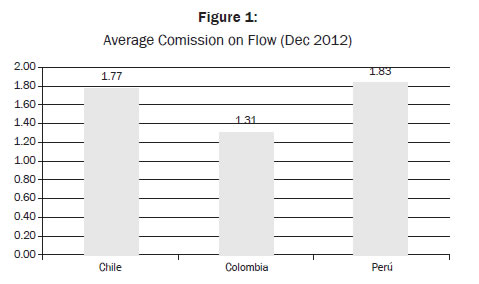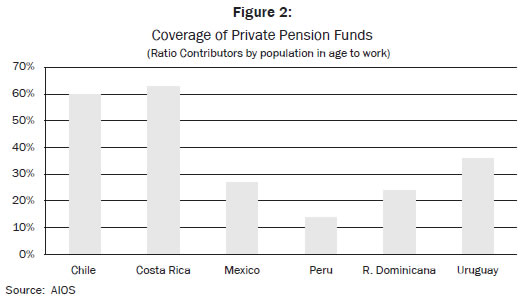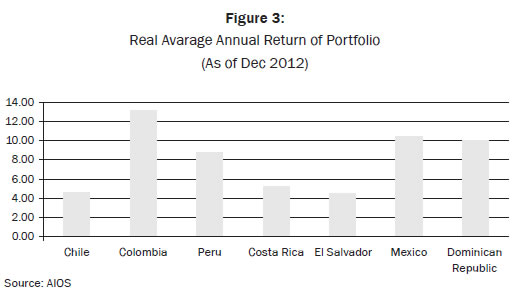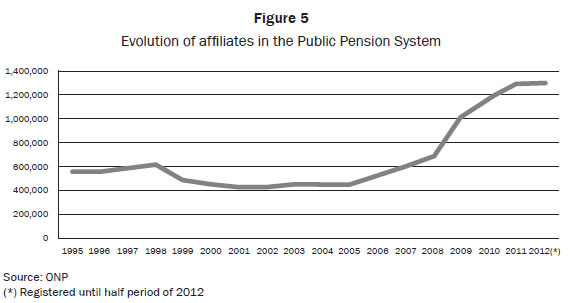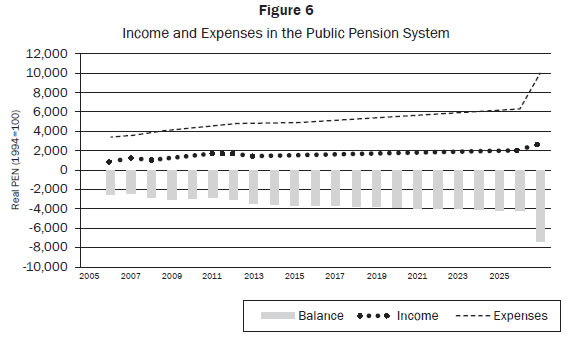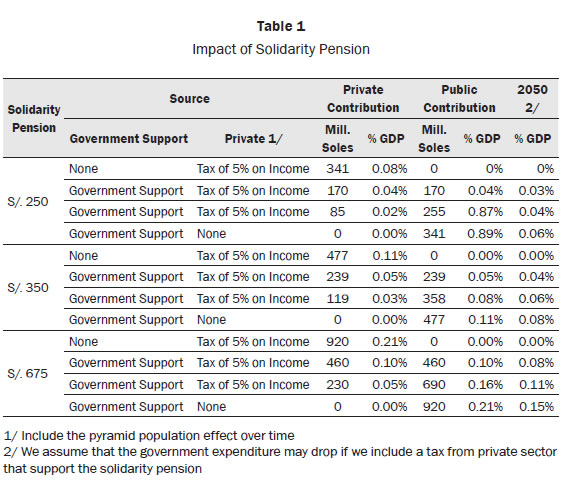Services on Demand
Journal
Article
Indicators
-
 Cited by SciELO
Cited by SciELO -
 Access statistics
Access statistics
Related links
-
 Cited by Google
Cited by Google -
 Similars in
SciELO
Similars in
SciELO -
 Similars in Google
Similars in Google
Share
Ecos de Economía
Print version ISSN 1657-4206
ecos.econ. vol.17 no.36 Medellín Jan./June 2013
ARTÍCULO DE INVESTIGACIÓN
Pay as you Go System versus Fully Funded Pension in Peru
Sistema Individual de Pensiones versus sistema colectivo de pensiones en Perú
Jorge B. Guillén*, Ruben Mosqueda**
* Doctor in Economics. Professor, Finance, Accounting and Economics ESAN, Peru [jguillen@esan.edu.pe].
** Doctor. Professor Tecnológico de Monterrey, México [ruben.mosqueda@itesm.mx]
Recibido: 16/01/2013 Aprobado: 10/05/2013
Abstract
The following paper analyses the sustainability of the Peruvian ''Pay as You Go System'' which is provided by the Government. In Peru, the ''Pay as you Go System'' coexists with Private Pension Funds or ''Fully Funded Pension''. Sometimes both systems compete with each other with advantages and disadvantages between them. We found that ''Pay as You Go System'' cannot be sustainable over a long period of time. In addition, based on a comparative analysis of advantages and disadvantages, we propose some recommendations to make Private Pension Funds (Fully Funded Pension) the best alternative to Pay as You Go System.
Key words: Fully Funded, Pay as You Go, Sustainability.
Resumen
Este trabajo analiza la sostenibilidad del sistema pensional colectivo implementado por el gobierno peruano. En Perú, este sistema coexiste con el de fondos privados de pensiones o fondo individual. En algunos casos, estos dos sistemas compiten entre sí, con sus ventajas y desventajas entre ambos sistemas. Según nuestros hallazgos, el sistema pensional de reparto colectivo de pensiones no es sostenible en un largo plazo. Asimismo, sobre la base de un análisis comparativo de las ventajas y desventajas entre ambos sistemas, se formulan algunas recomendaciones para que los fondos privados de pensión (Sistema Individual) se conviertan en la mejor alternativa al sistema pensional colectivo.
Palabras clave: Sistema Individual; Fondo provado de Pensiones; Sustenibilidad.
1. Introduction
There have been several points of view about pension systems. For instance Piñeira (1991, 1995) contrast Stiglitz and Orszag at al. (1999)'s point of view. The former shows that the private pension or Fully Funded Pension is the most suitable for governments' budget and hits the best income retirement for pensioners1. The latter, points out that there is a myth about how a competitive framework leads to low administrative costs in a decentralized pension fund.2 Stiglitz claims that administrative costs of these funds are relatively high because of advertising expenses, loss of economies of scale and several other costs.
The private pension fund (Fully Funded System) in Chile is a system that has been reproduced in several countries in Latin America as well as some Western European countries. In addition, Chile is the only country that has private pension system (Fully Funded) without competing with public pensions (Pay as You Go System)3.
This paper shed the light of comparing which system may work out better for a medium country in Latin America like Peru. We basically, analyze the sustainability of Pay as You Go System (Public Pension) versus Fully Funded Pension (Private Pension). Our hypothesis is that the Public Pension is unsustainable but in order to align the affiliate interests with the private pension institutions, we need to look for improvements in the private sector.
The following study proposes some policies that can make Private Pension Funds more attractive, reliable and efficient with the highest coverage. The policies under discussion will permit to keep a system of retirement pension fair for affiliates without any risk of internal political exposure. In addition, the proposed policies may complement the Peruvian government attempts to enhance the private pension funds.4
The paper is divided in the following sections: section 2, contains an assessment of the Private Pension under the wave of the second reform of pensions in Peru. Section 3; compare advantages and disadvantages between Public Pension and Private Pension. Section 4, discusses the sustainability of Public Pensions and finally, section 5 concludes and recommend some policies of improvement in private pension systems (Fully Funded Pension), along the line with a fiscal sustainability.
2. The Private Pension and the Second Reform in Peru
Despite that the Peruvian private pension system started 20 years ago. There are several challenges for the Private System (Fully Funded Pension). In 2012, the second reform started by hitting two main aspects in the system: Fees and Coverage. However the second reform may not achieve its objectives because it is under assessment in Peruvian courts due to possible violation of constitutional rights.
The second reform of private pension funds tries to lower Fees to the most competitive level. We have to mention that there are only four Private Pension Funds in Peru then the market structure is more like oligopoly. Thus, lowering fees is impossible unless it is regulated directly by the government. According to ''Asociación Internacional de Organismos de Supervisión de Fondos de Pensiones (AIOS)'', the Peruvian Fee is charge over the salary (Fee on flow). As of December 2012, the fee on flow averages 1.83% which contrast the equivalent fees charged by Chile (1.77%) and Colombia (1.31%) respectively.
Fee on balance was applied in Chile sometime in the past and actually they use fee on flow plus a fixed fee. Colombia charges fee on flow and Mexico fee on balance plus flow. The Peruvian regulator of private pensions is attempting to reduce commissions by charging a fee on balance.5 The regulator argument is that during a given lifetime individual's contribution, the charges is lower at the beginning and higher at the end. However, for Bernal (2008) the fee on flow and fee on balance can be equivalent each other. There should be an illusion of ''dropping fees'' because at the end the individual contributor will pay the same amount over their working lifetime.6
The other aspect to be challenge by the second reform in Peru is the problem of coverage (see figure 2). Peru faces the lowest ratios of coverage within the Latin-American region7 (16%) which contrast the coverage of 67% and 27% achieved by Chile and Mexico respectively. The coverage problem is always linked to evasion (Whitehouse, 2006) and informality. Higher ratios of evasion and informality bring to lower coverage for the private pension funds. The reform attempts to incorporate independents by discounting them pension payments besides tax payments. However, there are more segments of the labor that are not considered within the reform attempt to increase the coverage.
Also, in order to face the problem of coverage, the government has to bring some population's reliance on the private sector. After 20 years of launching the Private Pension Funds in Peru, there is some uncertainty between affiliates (See Moron, 2003 and Kapsoli, 2007). The return of equity (ROE) for Peruvian Private Pensions Funds is above 20 even within the worst Peruvian financial period (Superintendencia de Banca y Seguros). However, the unreliability in the private system does not reflect the fact that the Private Pension Funds have made a real return of portfolio above the average in the region (see figure 3).
The last reform of pensions has a claim for violation of constitutional rights.8 The claim can be summarized in the violation of constitutional rights because of two main aspects of the reform. First, the claim basically sustains that the Fee on Balance may trespass the right of ''intangibility of funds.'' Also, the last reform establishes a reverse auction of fees for new affiliates. The latter mechanism may violate the right to freely choose and it may incentives monopoly because the winner of the reverse auction should concentrate for itself the whole new affiliates for three years. The claim is under assessment by the Peruvian Constitutional Court. In contrast to the Mexican, Colombian and Chilean cases, the Peruvian constitution may not allow the establishment of the reforms that were described above.
Next section contrast advantages and disadvantages between the two pension systems in Peru: the Pay as you go system (Public pension) and The Fully Funded (Private Pension).
3. Comparison between Pay as you Go System and Fully Funded
The affiliated to Pay as You Go System (Public Pension) may achieve a minimum pension that is close to minimum wage. Before the Peruvian Reform for Private Pension Funds (2012) the Fully Funded System (Private Pension) did not have a guaranteed minimum pension. By looking at the ''Texto Único de Procedimientos Administrativos de AFPs en Peru (Ley 054-97) we may verify that there is not a minimum wage granted for contributor whenever his contribution was not good enough to program any fixed pension over time.9
The monthly retirement Income under the Pay as you Go System is around US$ 300 dollars which is very close to minimum wage in Peru. In contrast to Private Pension, the Public pension is granted for any amount of total contribution achieved by the contributor over his lifetime. In the private pension System, the only restriction to hit minimum pension is the number of years of contribution which is 20. For the private Pension, the restriction is only limited to the amount of money contributed without any limit in the number of years.
The last pension reform in Peru established that the Private Pension must have a ''Solidarity Pension'' which is very close to the minimum wage. This will permit to the Private Pension System to have a minimum pension like Public Pension. The new system makes the government to complements the affiliate's contribution, allowing the contributor to collect enough funds to hit a minimum pension close to the minimum wage.10
Therefore, after the Peruvian reform in the private pension system, there will be an alignment of benefits between the two pension systems: Fully Funded and Pay as You Go. In addition, the Fully Funded System gives higher pension as long as the contribution gets higher. The latter situation cannot be granted by Pay as You Go System so the final balance of benefits tilts toward the Fully Funded System. Next section will describe the economic consequences of keeping the Pays as You Go System.
4. Sustainability of Pay as You Go System
This section will analyze the sustainability of Pay as You Go System in terms of government expenses. Then we will compare how the ''Solidarity Pension'' proposed in the last reform may be less costly to the government. We will verify that the last option is possible for the Peruvian government and bring better benefits for the affiliate.
Our statistical analysis is two folded: the public and private sector. For the private sector, the data is taken from Asociación Internacional de Organismos de Supervisión de Fondos de Pensiones (AIOS). In addition, for the public sector we employ data from the Oficina de Normalización Previsional (ONP). The macroeconomic data has been collected from Banco Central de Reserva del Perú (BCRP) and the Instituto Nacional de Estadística e Informática (INEI).
In order to analyze the public sector, the variables income and expenses are collected from the Oficina de Normalización Previsional (ONP). The income represents all the contributions made by the affiliates to ONP and the expenses means the programmed payments to the retired people under Public System.
The figure below shows that the number of retired people under the ONP or Public Pension System hit almost half million people. This number should increase more, over time if we consider a scenario where the aging population increases at a rapid growth rate. Whenever the latter situation happens then the population pyramid gets broader on the peak and narrower on the base.11
The figure below shows the possible evolution of the population pyramid where there is a significant increase in the number of affiliates to the Public Pension System. It basically has been going from 558,144 affiliates to 1'304,569 affiliates which are eventually registered in 2012. This represents an increase of 133% within 17 years. It means that in average, we may expect for every year an increase of 19% of affiliates to ONP or Public Pension System
In order to find out the sustainability of the Pay as You Go System we have collected the data from CEPAL which forecast for 2050, a population of 42 million people in Peru, which represent an increase of 50% for an horizon of 38 years.
The composition of the projected new population in 2050 is different to the actual composition of population. There will be elderly people in 2050. The latter fact can be explained because of the new advances in medicine and technology as well as incentives to reduce the number of sons for a better quality of life. This phenomenon has occurred already quickly in some countries like Chile and Argentina, which is the same situation that USA and Western European countries are experiencing.
The last phenomenon has being analyzed deeply in countries like USA. It received the name of ''baby boomer''. The fact that there is some change in the birth rate has been explained by Lusardi and Mitchell12 (2007) who found that certain cohort gets to retirement wealthier because they are able to plan in advance financially much better than their peers. The financial planning includes the choice of the number of kids that matches their financial requirements.
Along the line of previous analysis we have forecast what the ONP's income and expenses will be within the next 38 years. The forecast of population made by CEPAL is an input to start up building the numbers. CEPAL is able to give the distribution of ages for the next 38 years. The latter data permit us to build up the forecast of expenses for the Public Pension System. The details of population forecast made by CEPAL permit us to infer what the number of retirements will be under the Public Sector. We assume that the retirement coverage of pension will progressively go from 29% to 46% of the population within retirement age.
We assume that 3% of Peruvian GDP is collected in the Public Pension System.13 The real growth rate of GDP14 is assumed to be 3% flat and the deflator grows at a constant ratio of 1%. The latter data permit us to build up the income for Public Sector System.
The figure below summarizes the simulation of results for Public Pension System's income and expenses over the next 38 years. We can see that there is a gap between income and expenses because the number of contributors does not fill the retirements. Even today there is a gap of 3000 million dollars. If we add all the gaps over the period of forecast and assume the same coverage and ratio of real growth of GDP then the outstanding debt for pension will be 30% of the Peruvian real GDP.15
Taking into account that the country is export oriented to commodities then the fiscal sustainability is under exposure. Therefore, Peruvian external vulnerabilities may be deepened whenever there is a scenario where international interest rates will jump to level of 80's.16 The only possibility to avoid any possible fiscal vulnerability is to close the gap in the Public Pension System.
Chile is the only country with the private sector of pensions working alone. In most of the countries in the Latin American region both systems coexist: Fully Funded (Private Pension) and Pays as You Go System (Public Pension). The possibility to have a Private Pension System with a solidarity pension could fill the forgone benefits of missing the unsustainable Public Pension System.
The Table below introduces some calculations that consider a scenario of Private Pension System with Pension Solidarity. The government will face payments that represent 0.15% of GDP for 2050. This is a cheaper option instead of having a Public Pension System that may trigger a fiscal vulnerability in the Peruvian economy.
In order to make our analysis comparable to the former, we assume the same level of coverage that we did for the later simulation (around 29%). The level of government assistance may increase as long as the coverage rises. Also, to capture the people that need government assistance, we employ the data from ''Encuesta Nacional de Hogares del Peru'' which is published by the Instituto Nacional de Estadística e Informatica (INEI).
After having the coverage and the people under assistance, we have made some simulations for different level of pensions. Basically government expenditure is cheaper in an scenario of Private Pension System working alone with Solidarity Pension17.
5. Conclusions
We have found that Peruvian Pay as You Go system (Public Pension) may be unsustainable over time. Similar case experienced some Western European countries as well as The United States of America.
The fiscal unsustainability may be triggered shortly if we consider a negative shock in commodities plus increases in international interest rates. The Peruvian economy is still dependent on external variables, so there has to be some actions to close the gaps in the ''Pay as You Go System.''
By closing the Pay as You Go System, the unsustainability of the Peruvian Public Pension System disappears. However, to fill the gap of benefits that the private system may forgone is to introduce the ''solidarity pension'' which works perfectly in Chile and Colombia.
An interesting further research may be to compare the Peruvian constitution against Colombian and Chilean constitution. The latter comparison will permit to find out why there is only a possible violation of Peruvian constitutional rights during the implementation of any reform that attempts to lower commissions and increase the coverage.
Notas al pie
1 Piñeira claims that the ''Pay as You Go'' comes from German Bismarck's system of pensions which have recently induced large fiscal deficits in industrialized economies. According to the author, the Fully Funded works in an environment similar to XIX century, where expectance of life is low and pyramid of population is broader in the base. Now, after some advances in medicine and technology, the base (young) is not enough broad to cover the peak (retired people). Therefore fiscal imbalances may come out.
2 In Latin America, a centralized pension fund may work when the government manages the funds with the private sector.
3 The Fully Funded Pension is also called private pension system and the Pay as You Go System corresponds to the public sector.
4 The improvements must fill the gap between Fully Funded and Pay as You Go System. Replacement of Fully Funded for Pay as you Go System cannot be guaranteed without some reforms in the latter system.
5 See Bernal et al (2008) for a discussion of fees for Private Pension Funds. Also see for more details in Kay and Sinha (2009)
6 If you compare both payments: Fee on Balance and Fee on Flow, there is always an equivalent ratio that may bring both sums of fee payments over working lifetime equivalent each other.
7 The ratio considers contributors over population in age to work. See also Rofman et. Al (2008).
8 The claim has been introduced by some fractions of the Peruvian congress.
9 Basically the TUPA claims that if the contribution is low then the full amount of it is returned to the respectively contributor. Only when the full contribution hit certain amount of money, then any program of payment is scheduled. Most of the time, the program of payments are close to minimum wage and above.
10 Also, the ''solidarity pension'' may increase as long as the contribution gets higher and the government award it with higher subsidy.
11 For more about this phenomenon see Bernal, N. et al, (2008), and also Kay, Stephen J. & Sinha, Tapen (ed.), 2007. They describe how Peru and Latin-American Region will face an inverted population pyramid through 2025, similar phenomenon experienced developed countries some years ago.
12 They used Data for the USA and the same situation occurs in Western European countries.
13 During past periods this ratio was the average of income as share of GDP. We assume that the ratio remains the same for the next 38 years of forecast.
14 At the beginning the growth of GDP is 6% until 2015 then the growth will be constant at 3% until 2050. The latter situation is explained because of decreasing return to scale within a medium country like Peru. Similar forecast has been revised by IMF and World Bank.
15 The situation is similar to the fiscal problems in Europe and USA. This will be the Peruvian baby boomers that the local economy will face.
16 USA and European countries have more internal debt than external. In case of Peru, as many Latin America countries, the debt is more external so the exposure to international interest rate is likely.
17 Restrepo and Gutierrez (2011) found that higher density help to reduce the government intervention and guarantees a minimum pension.
References
Asociación Internacional de Organismos de Supervisión de Fondos de Pensiones (AIOS). Base de Datos de AFPs en Latinoamérica. [ Links ]
Banco Central de Reserva del Perú (BCRP ). Memorias y Notas Semanales. [ Links ]
Bernal, N. et al, (2008), ''Una mirada al sistema peruano de pensiones: diagnóstico y propuestas''. Estudios previsionales del BBVA. [ Links ]
Comisión Económica para América Latina y el Caribe (CEPAL). Datos demográficos de CELADE – División de Población. [ Links ]
Crabbe, Carolin A. (2005) A Quarter Century of Pension Reform in Latin Amereica and the Caribean: Lessons Learned and Next Steps. Washington DC. IDB. 409p [ Links ]
Instituto Nacional de Estadística e Informática (INEI ). Estadísticas y Cuentas Nacionales. [ Links ]
Instituto Nacional de Estadística e Informática (INEI ). Encuesta Nacional de Hogares del 2011. [ Links ]
Kay, Stephen J. & Sinha, Tapen (ed.), 2007. ''Lessons from Pension Reform in the Americas,''OUP Catalogue, Oxford University Press, number 9780199226801, March. [ Links ]
Ley 054-97 de Creación del Sistema Privado de Pensiones Peruano (1997) Texto Unico Ordenado de la Ley del Sistema Privado de Administración de Fondos de Pensiones. Ministerio de Economía y Finanzas. [ Links ]
Ley de Reforma de Pensiones 29903 (2012). Comisión Permanente del Congreso de la República del Perú [ Links ].
Lusardi A., and Mitchell O. (2007) ''BabyBoomer retirement security: The roles of planning, financial literacy, and housing wealth. Volume 54, Issue 1, January 2007, Pages 205–224. [ Links ]
Oficina de Normalización Previsional (ONP). Base de datos del Sistema Nacional de Pensiones. [ Links ]
Piñeira, J., (1991), ''El cascabel al gato: la batalla por la reforma previsional'', Editorial Zigzag. Santiago. [ Links ]
Piñeira, J., (1995), ''Empowering workers: The Privatization of Social Security in Chile'', CATO. Vol. 15, N° 2-3. [ Links ]
Restrepo J., Gutierrez J. (2011) ''Valoración de la garantía de pensión en las cuentas de ahorro individual en Colombia'', Innovar, vol. 21, No 41, págs. 51-62 [ Links ]
Rofman, Rafael et. Al. (2008) ''Pension system in Latin America – Concepts and measurements of coverage. Wold Bank. Discussion Paper 0616. [ Links ]
Stiglitz, J. and P. Orszag (1999), ''Rethinking Pension Reform: Ten Myths about Social Security Systems'', paper presented at the Conference on ''New Ideas About Old Age Security'', 14-15 September, The World Bank, Washington, D. C. [ Links ]
Superintendencia de Banca y Seguros del Perú (SBS). Base de datos del sistema privado de pensiones peruano. [ Links ]













